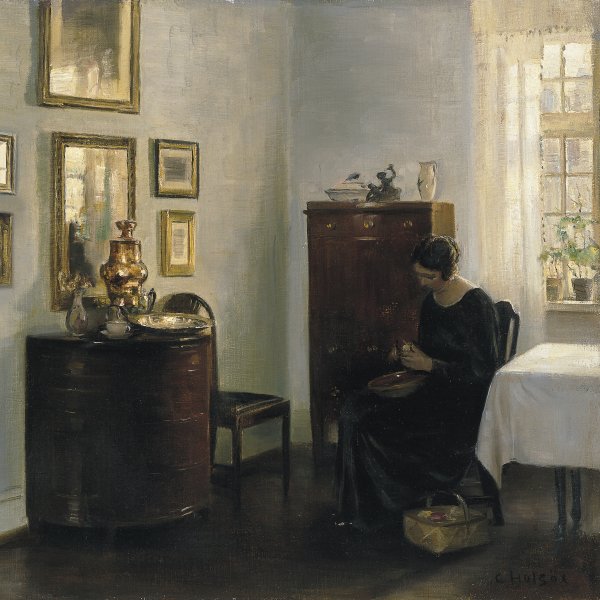Carl Holsoe
Arhus, 1863-Asserbo, 1935
Holsoe was a talented Danish interior painter, born in the town of Aarhus. Having trained as a painter, he entered the Kongelige Danske Kunstakademi in Copenhagen in 1882, and in 1884 the Kunstnernes Studieskole under the famous Danish painter P. S. Krøyer. His fellow students at the academy and at the Kunstnernes Studieskole included Peter Ilsted and Vilhelm Hammershøi, with whom he was to form the elite of Danish interior painters. Holsoe, who was married twice, settled outside Copenhagen in the village of Asserbo.
Holsoe quickly reached maturity as an interior painter. His first works in this genre, exhibited in 1886, were well received by Danish critics, who recognised his talents and compared his painting with the Dutch masters of the 17th century. In his paintings, Holsoe employed a realistic, academic style, producing serious, painterly descriptions of his interiors. He developed a particular affection for interior subjects which reveal a strong structural sense, precise vision, and first-hand observation of the room and the light. In addition to this subject, Holsoe is also known for his landscapes, still lifes and flower paintings, all produced in the same clear, realist manner. However, his main subject was that of interiors, which he produced in a large number of variations. He particularly focused on the pieces of polished mahogany furniture, the white walls and other objects that decorate these drawing rooms, studying the fall of light on them. The female figure that he usually includes, sitting or standing in the background of the paintings, is merely another decorative element.
Holsoe became famous in his lifetime as a painter of interiors both in Denmark and in Sweden, receiving various international awards. At the Universal Exhibition in Paris in 1889 he gained an "Honourable Mention ", while at the international exhibition held in Munich in 1891 he was awarded the gold medal. In Denmark he received the Eckersberg.
Rigmor Lovring
Holsoe quickly reached maturity as an interior painter. His first works in this genre, exhibited in 1886, were well received by Danish critics, who recognised his talents and compared his painting with the Dutch masters of the 17th century. In his paintings, Holsoe employed a realistic, academic style, producing serious, painterly descriptions of his interiors. He developed a particular affection for interior subjects which reveal a strong structural sense, precise vision, and first-hand observation of the room and the light. In addition to this subject, Holsoe is also known for his landscapes, still lifes and flower paintings, all produced in the same clear, realist manner. However, his main subject was that of interiors, which he produced in a large number of variations. He particularly focused on the pieces of polished mahogany furniture, the white walls and other objects that decorate these drawing rooms, studying the fall of light on them. The female figure that he usually includes, sitting or standing in the background of the paintings, is merely another decorative element.
Holsoe became famous in his lifetime as a painter of interiors both in Denmark and in Sweden, receiving various international awards. At the Universal Exhibition in Paris in 1889 he gained an "Honourable Mention ", while at the international exhibition held in Munich in 1891 he was awarded the gold medal. In Denmark he received the Eckersberg.
Rigmor Lovring





